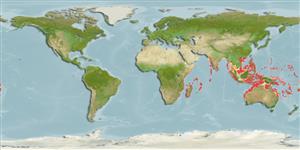Environment: milieu / climate zone / depth range / distribution range
ນິເວດວິທະຍາ
ສັດທະເລ ກ່ຽວກັນຫີນ; ລະດັບຄວາມເລິກ 50 - 300 m (Ref. 4319). Tropical; 21°N - 32°S, 30°E - 179°W (Ref. 5222)
Indo-West Pacific: Natal coast of South Africa, northern Mozambique, Reunion, Mauritius, New Caledonia, Philippines, New Guinea, New Ireland, and Fiji. Recently recorded from Tonga (Ref. 53797). Unknown in the Red Sea and Persian Gulf.
ຂະໜາດ / ນ້ຳໜັກ / Age
Maturity: Lm ? range ? - ? cm
Max length : 150 cm TL ຕົວຜູ້/ບໍ່ມີເພດ; (Ref. 4787); ນ້ຳໜັກສູງສຸດທີ່ເຄຍຈັດພີມມາ: 50.0 kg (Ref. 4787)
ຄີ (ໜາມ)ແຂງຢູ່ຫຼັງປາ (ທັງໝົດ): 11; ຄີຫຼັງຂອງປາ (ຄີອ່ອນ) (ທັງໝົດ): 14-15; ຄີ(ໜາມ) ແຂງຢູ່ຄີກົ້ນປາ
ກຸ່ມປາກະດູກແຂງ
ຄວາມຖີ່ຂອງກຸ່ມຖ່າຍທອດພັນ
ປາທີ່ມີການເຄື່ອນຍ້າຍຈາກທະເລໄປຫານ້ຳຈືດ ແລະນ້ຳຈືດຫາທະເລ
ປາທີ່ມີການເຄື່ອນຍ້າຍຈາກທະເລແລະໄປໄຂ່ຢູ່ນ້ຳຈືດ
ຄີກົ້ນຂອງປາ
ສັດທີ່ມີກະດູກສັນຫັຼງ
ການຖ່າຍທອດທາງກຳມະພັນຈາກພໍ່ແມ່ຫາລູກ 3; ຄີກົ້ນຂອງປາ: 8. Distinguished by the following characteristics: pale brown body color with small dark brown to greyish green spots unevenly scattered on the dorsolateral parts of the head and body, dorsal and caudal fin; one row of close-set spots running posteriorly from the eye in a distinct line; absence of spots on the body below the level of the pectoral fins or on the anal and paired fins; body depth contained 2.7-3.2 times in SL; head length 2.2-2.4 times in SL; flat to convex interorbital area, dorsal head profile almost straight; angular preopercle, 2-4 distinctly enlarged serrae at angle; slightly convex upper edge of operculum; posterior nostril not much larger than anterior nostril; maxilla reaches below rear half of eye, ventral edge with low step at the distal expansion; 2 rows of teeth on midlateral part of lower jaw, inner teeth larger than outer teeth (Ref. 89707).
Known only in deep water in the vicinity of coral reefs. Biology unknown. It is an excellent food fish.
Life cycle and mating behavior
ການຈະເລີນເຕັມໄວ | ການສືບພັນ | ການວາງໄຂ່ | ໄຂ່ | ຄວາມດົກຂອງໄຂ່ປາ | ຕົວອ່ອນ
Heemstra, P.C. and J.E. Randall, 1993. FAO Species Catalogue. Vol. 16. Groupers of the world (family Serranidae, subfamily Epinephelinae). An annotated and illustrated catalogue of the grouper, rockcod, hind, coral grouper and lyretail species known to date. Rome: FAO. FAO Fish. Synop. 125(16):382 p. (Ref. 5222)
IUCN Red List Status (Ref. 130435)
Threat to humans
Harmless
Human uses
ການປະມົງ: ເປັນສີນຄ້າ
ຂໍ້ມູນຕື່ມອີກ
ເອກະສານອ້າງອີງການລ້ຽງສັດນ້ຳຂໍ້ມູນການລ້ຽງສັດນ້ຳສາຍພັນກຳມະພັນElectrophoresesການຖ່າຍທອດທາງກຳມະພັນຈາກພໍ່ແມ່ຫາລູກພະຍາດການປຸງແຕ່ງNutrientsMass conversion
ຜູ້ຮ່ວມມືຮູບStamps, Coins Misc.ສຽງຫອຍມີພິດຊະນິດນຶ່ງທີ່ອາໄສໃນທະເລຄວາມໄວປະເພດການລອຍເນື້ອທີ່ເຫືອກOtolithsສະໝອງວິໄສທັດ
ເຄື່ອງມື
Special reports
Download XML
ແຫຼ່ງອີນເຕີເນັດ
Estimates based on models
Preferred temperature (Ref.
123201): 17.9 - 27.6, mean 23.7 °C (based on 194 cells).
Phylogenetic diversity index (Ref.
82804): PD
50 = 0.5000 [Uniqueness, from 0.5 = low to 2.0 = high].
Bayesian length-weight: a=0.01820 (0.01098 - 0.03017), b=3.10 (2.96 - 3.24), in cm total length, based on LWR estimates for this species & Genus-body shape (Ref.
93245).
ຊັ້ນເຂດຮ້ອນ (Ref.
69278): 4.1 ±0.5 se; based on size and trophs of closest relatives
ຄວາມຢືດຢຸ່ນ (Ref.
120179): ຕຳ່, ປະຊາກອນຕຳ່ສຸດທີ່ໃຊ້ເວລາສອງເທົ່າ 4.5 - 14 ປີ (tmax=11; Fec=46,769).
Fishing Vulnerability (Ref.
59153): Very high vulnerability (90 of 100).
Nutrients (Ref.
124155): Calcium = 15.1 [7.1, 33.8] mg/100g; Iron = 0.431 [0.219, 0.880] mg/100g; Protein = 18.8 [17.3, 20.2] %; Omega3 = 0.125 [0.072, 0.215] g/100g; Selenium = 66.9 [36.0, 135.9] μg/100g; VitaminA = 76.6 [20.8, 280.9] μg/100g; Zinc = 0.862 [0.587, 1.270] mg/100g (wet weight);
